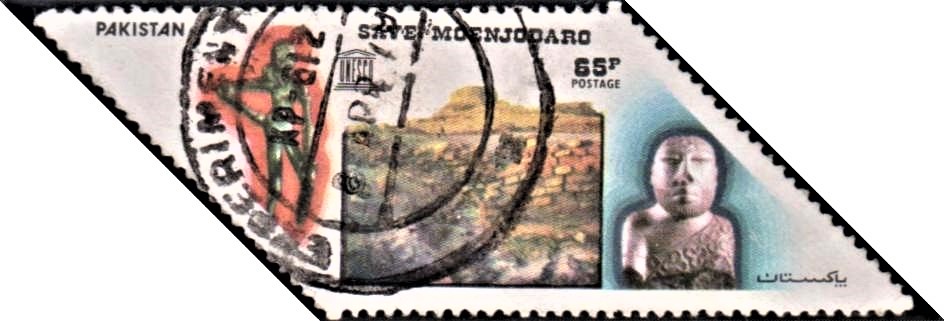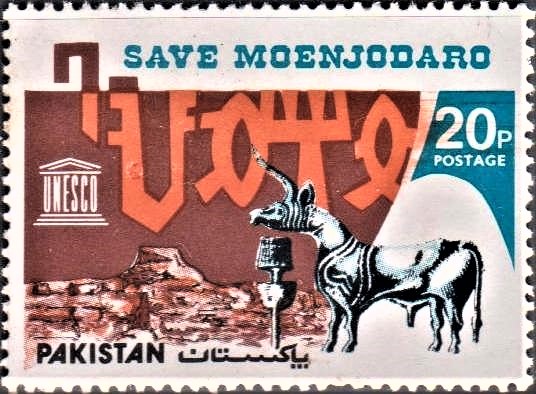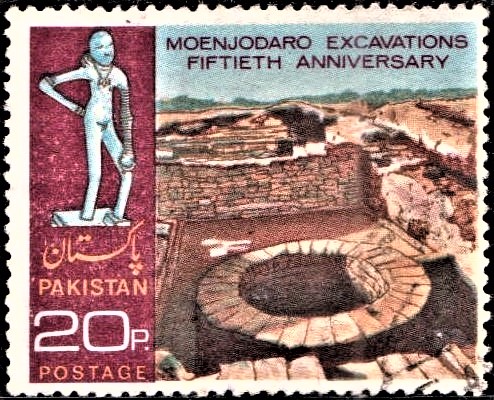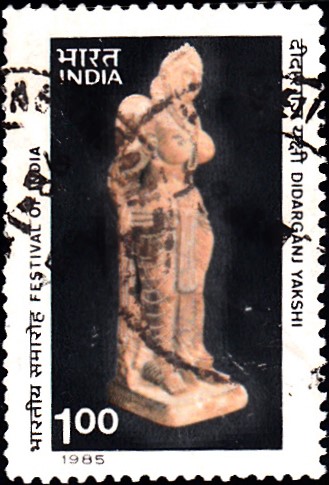
Pakistan on Save Moenjodaro 1976
A commemorative postage stamp on the Save Mohenjodaro Campaign :
 Issued by Pakistan
Issued by Pakistan
Issued on Aug 31, 1976
Issued for : As a part of an international appeal for assistance to preserve Moenjodaro, the Pakistan Post Office in collaboration with the Authority for the Preservation of Moenjodaro (Pakistan) has arranged to bring out a series of commemorative stamps for public motivation. The first issue of the Save Moenjodaro Series consisted of a set of five stamps of different denominations and was brought out on 29th February, 1976. As indicated previously Pakistan Post Office will be issuing a stamp in this series after every three months for a period of one year. Accordingly the third issue is being brought out on 31st August, 1976. This is a 65 Paisa stamp.
Description : The stamp is horizontal and a parallelogram in format. In the central square portion is shown general view of Moenjodaro citadel area, the salinity affected area being visible in the foreground. The caption “Save Moenjodaro” runs along the top of the square in black. The UNESCO emblem and the denomination figure with the word ‘postage’ underneath appear respectively at the top left and right side of the square in black. In the triangular portion at left appears one of the archaeological finds of Moenjodaro the bronze statue of “the dancing girl” against an enclosing red background.
In the triangular portion at right appears another famous archaeological find of Moenjodaro “the King Priest” against an enclosing background of blue colour, “Pakistan” in English and Urdu appears in the top left and bottom right corners of the stamp respectively in black.
Designer : Adil Salahuddin
Type : Stamp, Postal Used
Denomination : 65 Paisa
Colours : Yellow, Magenta, Cyan, Black
Vertical Height of Stamp : 26 m.m.
Size of Stamp : 36.77 x 52 m.m.
Size of Print : 33.50 x 48.50 m.m.
Perforation Gauge : 14 C
Quantity : 9,80,000 (49 Set)
No. of Stamps in each sheet : 49
Process of Printing : Litho Offset
Printers : Pakistan Security Printing Corporation Ltd., Karachi
About :
- Moenjodaro was one of the main centres of culture that flourished in the Indus valley 5,000 years ago. This archaeological site is now in danger as a result of erosion caused by rising underground water level. It is the opinion of experts that, unless preserved, Moenjodaro is in danger of total destruction within the next 30 years.
- Measures to save Moenjodaro have been devised by the Pakistani authorities with the help of UNESCO experts. The total cost of the priority work will be 7,500,000 dollars and it will take 5 years to complete it. It is obvious that for a task of this magnitude the technical and financial resources of Pakistan are not sufficient.
- Problems Facing Moenjodaro and Their Remedial Measures
- It is a paradox of facts that the ruins of Moenjodaro buried beneath the accumulations of five thousand years remained in an excellent state of preservation. But as soon as they were exposed from oblivion to the incredible gaze of the 20th century, they were overtaken by water logging and salinity. These two diseases combined with the threat of bank erosion by the Indus River, pose a grim danger to the existence of one of the most valuable cultural legacies of the human race. If ever the world felt concerned for sinking Venice, it must feel desperate at the crumbling of Moenjodaro; if ever the world’s conscience was roused to save Abu Simbel, it must be shaken to save Moenjodaro.
- The phenomenon of salt encrustation on the bricks and structures of the ruins was noticed during and immediately after the excavations in the early twenties. The swelling of water-table, which had already risen by several feet during the excavation period, was observed to be the main cause of decay of the structures. Certain chemical measures for the preservation of these ruins were adopted, but these methods were a palliative and not a cure of the malady.
- The site was left unattended for several years during the Second World War and in this interval, the effect of salts and the defective drainage played havoc on the remains. In 1940, efforts were made to remove salts from the structures and the remains of the Great Bath were washed with plain water and given chemical treatment. In 1948 mud plaster and mud brick capping was applied to some structures with considerably successful results. These homespun techniques have been in use since then to the extent of the available funds. In nature and scope these techniques, however, serve only to slow down the rate of disintegration of the remains.
- The importance of the archaeological remains at Moenjodaro attracted the attention of specialists and laymen alike. It is doubtful if any advanced country, had it inherited Moenjodaro, would have done more for its preservation than what has been done so far by Pakistan despite her tight economy. In 1960, the Government of Pakistan opened negotiations with the UNESCO, inviting their technical advice in response of which a number of individual experts and missions of experts have since visited the country to study the situation and suggest remedial measures.
- In order to save this priceless heritage from total extinction, the Government of Pakistan have prepared a Master Plan, which has since been approved by the UNESCO. Besides, UNESCO have also pledged to make financial contribution towards the execution of the aforesaid Master Plan.
- Issued by: The Director General, Pakistan Post Office, Karachi.







